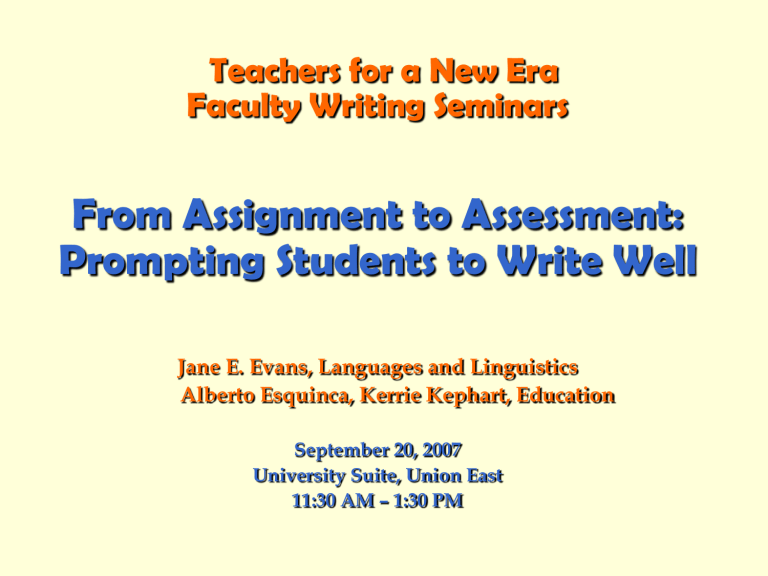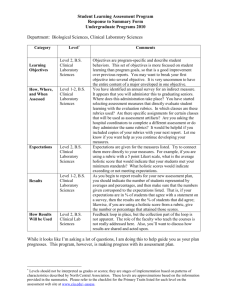From Assignment to Assessment: Prompting Students to Write Well

Teachers for a New Era
Faculty Writing Seminars
From Assignment to Assessment:
Prompting Students to Write Well
Jane E. Evans, Languages and Linguistics
Alberto Esquinca, Kerrie Kephart, Education
September 20, 2007
University Suite, Union East
11:30 AM – 1:30 PM
Features of an Effective
Assignment Prompt
Task and Purpose – explain what you want students to do in the paper, and why.
Writer’s role – to inform? persuade? critique? incite?
Audience – who should be addressed?
Process – what procedures should be followed? when are the due dates?
Format – specify page length, margins, spacing, etc.
Criteria – provide a rubric with your grading criteria.
See: http://www.unm.edu/~wac/CurriculumResources/GradingRubric.pdf
.
Discussion
• For advanced courses, #1 might be appropriate.
Short, to the point.
• #1 not enough guidance; #2 may be overly prescriptive (for grad students)
• #2 is more structured; easier to hold students accountable; it models what should be included
• More information is better than less; #1 gives the impression that instructor is not engaged.
• #2 provides a good checklist for students who haven’t written in a while.
• Depends also on when the prompt appears in the sequence of assignments – later on, maybe less info necessary
• #1 could be better if it at least referred to some things already covered in class
• #1 could cause confusion
• #2 also has some terms that students might need to have defined – e.g., “transition sentences”
• Depends on the discipline – presumably students have some background that helps them interpret #2
• Depends on how the prompt is delivered – is it discussed in class?
Evaluation Rubrics:
What are they? Why use them?
• A scoring tool
• Tied to course goals or objectives
• Linked to assignment purpose
• Make grading more transparent and fair
• Make scoring more reliable and faster
• Make evaluation criteria explicit and available to students before paper is due
Features of a rubric
• Uses a range to rate performance
• Contains performance characteristics arranged in levels where each level indicates the degree to which a standard has been met
• Includes a narrative description of the criteria
Rubric types
Depending the purpose of assignment:
Analytic versus holistic
– Can the evaluation criteria be separated into independent factors?
– Is there a pedagogically sound reason to separate each factor?
General versus task specific
– Is the assignment one of several similar ones to be completed throughout the semester?
– Does each assignment assess different knowledge & skills?
Analytic vs. Holistic Rubrics
• Analytic: focus on clarity of writing, spelling, grammar, formatting
• Holistic: focus on persuasiveness, for example.
General vs. Task-Specific Rubrics
• General: Same rubric is used for all oral presentations during the semester – the purpose is for students to develop oral language proficiency.
• Specific: Task-specific rubrics assess different knowledge and skills
Create Your Own Rubric
1. Identify the type and purpose of the Rubric.
2. Identify distinct criteria to be evaluated
3. Determine your levels of assessment
4. Describe each level for each of the criteria, clearly differentiating between them
5. Involve learners in development and use of the rubric
6. Pre-test and retest your rubric
See: http://rubistar.4teachers.org/index.php
Supporting Students
Throughout the Writing Process
• Read the assignment prompt in class and allow students to ask questions to clarify
• Break complex assignments into smaller parts, with sequenced due dates, e.g.:
1) Topic Area Statement
2) Library Assignment
3) Paper Prospectus
4) First Version of Paper (for Peer Review * )
5) Second Version of Paper (for Peer Review * )
6) Instructor-Student Conferences *
7) Paper Outlines
8) Final Version of Paper
*Topics for a future seminar


